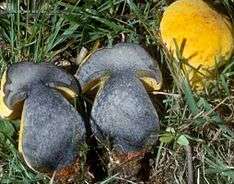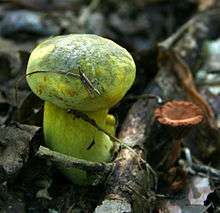Neoboletus pseudosulphureus
Sutorius junquilleus is a species of bolete fungus in the family Boletaceae.[1] It is found in Europe, Central America, North America, and India, where it grows in deciduous and mixed forests. Initially uniformly yellow in color, all external surfaces of the fruit body undergo a variety of discolorations as it matures.
| Neoboletus pseudosulphureus | |
|---|---|
 | |
| Scientific classification | |
| Kingdom: | |
| Division: | |
| Class: | |
| Order: | |
| Family: | |
| Genus: | |
| Species: | Sutorius junquilleus |
| Binomial name | |
| Sutorius junquilleus (Kallenb.) W. Klofac (2015) | |
| Synonyms"Boletus junquilleus",
"Neoboletus junquilleus", | |
|
Boletus pseudosulphureus Kallenb, "Neoboletus pseudosulphureus", "Sutorius pseudosulphureus" | |
Habitat and distribution
The fungus is known from Europe, eastern North America, and Costa Rica,[2] [3] where it fruits on the ground in deciduous and mixed forests, usually in a mycorrhizal association with oak, but occasionally with pine.[4] It was reported from Himachal Pradesh, India for the first time in 1993.[5]
Taxonomy
The fungus was first described scientifically by German mycologist Franz Joseph Kallenbach in 1923, from collections made in Germany.[6] A year later, Kallenbach published a more thorough description.[7] Some authors have historically considered Sutorius junquilleus—a species described by Lucien Quelet in 1897—to be a synonym, including first Gilbert and Leclair in 1942,[8] and Rolf Singer in 1947.[9][10]. Reid has suggested that differences are due only to climatic conditions, with the red colors appearing in conditions of lower temperature.[11] It was transferred to the genus Neoboletus in 2015.[12]
Description

The mushroom has a cushion-shaped to convex cap measuring 4–12 cm (1.6–4.7 in) wide. The cap color is bright yellow when young, fading to dull yellow or tan when mature, and usually develops orange or reddish discolorations. The pore surface is initially bright yellow before turning greenish yellow to brownish yellow. The stem is 4–12 cm (1.6–4.7 in) long by 2–5 cm (0.8–2.0 in) thick, and somewhat thicker near the base. Although it is usually not reticulate, the upper part of the stem may have reticulations. All parts of the mushroom stain blue to bluish black when injured.[4] The stark color changes that occur over the lifespan of the fruit body led one author to suggest that "the mushroom's personal grooming skills go to hell in a handbasket".[13] A variety S. junquilleus var. pallidus, found in Nova Scotia, is pale yellow with a lighter colored olive spore print compared to the nominate variety.[4]
.
References
- "Boletus pseudosulphureus Kallenb. 1923". International Mycological Association. Retrieved 2012-10-05.
- Halling RE. "Boletus pseudosulphureus Kallenbach". New York Botanical Gardens. Retrieved 2012-10-05.
- Halling RE, Mata M, Mueller GM (2004). "Three new boletes for Costa Rica". In Cripps CL (ed.). Fungi in Forest Ecosystems: Systematics, Diversity, and Ecology. New York Botanical Garden Press. pp. 33–59. ISBN 978-0-89327-459-7.
- Bessette AE, Roody WC, Bessette AR (2000). North American Boletes. Syracuse, New York: Syracuse University Press. p. 142. ISBN 978-0815605881.
- Sagar A, Lakhanpal TN (1993). "Fleshy fungi of N.W. Himalayas-XV. Six species of Boletus new to India". Indian Journal of Mycology and Plant Pathology. 23 (3): 227–31. ISSN 0303-4097.
- Kallenbach F. (1923). "Boletus pseudo-sulphureus n. sp". Zeitschrift für Pilzkunde (in German). 2: 225–30.
- Kallenbach F. (1924). "Boletus pseudo-sulphureus n. sp". Annales Mycologici (in German). 22: 239–44.
- Gilbert E-J, Leclair A (1942). "Notules sur les bolets". 3e série, Bulletin trimestriel de la Société mycologique de France (in French). 58: 170–89.
- Singer R. (1947). "The Boletineae of Florida, with notes on extralimital species. III. The Boletoideae of Florida". American Midland Naturalist. 37: 1–126. doi:10.2307/2421647.
- Klofac W. (2011). "Boletus pseudosulphureus, der gultige Name fur den teilweise fehlinter-pretierten Boletus junquilleus?" [Boletus pseudosulphureus, the correct name for the partly misinterpreted Boletus junquilleus?]. Osterreichische Zeitschrift fur Pilzkunde (in German) (20): 53–72.
- Reid D. (1968). Coloured Icons of Rare and Interesting Fungi. Part 3. Nova Hedwigia. Lehre, Germany: J. Cramer. p. 5.
- Klofac W. (9 March 2015). "Nomenclatural novelties". Index Fungorum (228): 1. ISSN 2049-2375.
- Kuo M. (March 2005). "Boletus pseudosulphureus". MushroomExpert.com. Retrieved 2012-10-05.